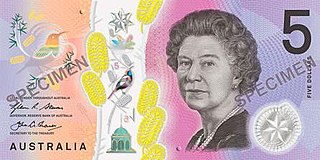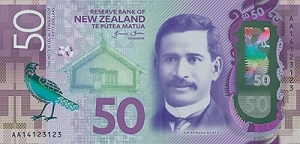
The New Zealand dollar is the official currency and legal tender of New Zealand, the Cook Islands, Niue, the Ross Dependency, Tokelau, and a British territory, the Pitcairn Islands. Within New Zealand, it is almost always abbreviated with the dollar sign ($). The abbreviations "$NZ" or "NZ$" are used when necessary to distinguish it from other dollar-denominated currencies.

The Singapore dollar is the official currency of the Republic of Singapore. It is divided into 100 cents. It is normally abbreviated with the dollar sign $, or S$ to distinguish it from other dollar-denominated currencies. The Monetary Authority of Singapore (MAS) issues the banknotes and coins of the Singapore dollar.
The Canadian twenty-dollar note is one of the most common banknotes of the Canadian dollar; it is the primary banknote dispensed from Canadian automated teller machines (ATMs). The newest version, the Frontier Series polymer note, was released to the general public on November 7, 2012, replacing the banknote from the Canadian Journey Series.

The Fijian dollar has been the currency of Fiji since 1969 and was also the currency between 1867 and 1873. It is normally abbreviated with the dollar sign $, or alternatively FJ$ to distinguish it from other dollar-denominated currencies. It is divided into 100 cents.

The Canadian fifty-dollar note is one of the most common banknotes of the Canadian dollar. It is sometimes dispensed by ATMs but not as commonly as the $20 note.
The tālā is the currency of Samoa. It is divided into 100 sene. The terms tālā and sene are the equivalents of the English words dollar and cent in the Samoan language. Its symbol is $, or WS$ to distinguish it from other currencies named dollar.

Banknotes of the Canadian dollar are the banknotes or bills of Canada, denominated in Canadian dollars. Currently, they are issued in $5, $10, $20, $50, and $100 denominations. All current notes are issued by the Bank of Canada, which released its first series of notes in 1935. The Bank of Canada has contracted the Canadian Bank Note Company to produce the Canadian notes since then. The current series of polymer banknotes were introduced into circulation between November 2011 and November 2013. Banknotes issued in Canada can be viewed at the Bank of Canada Museum in Ottawa.

The Australian fifty-dollar note is an Australian banknote with a face value of fifty Australian dollars (AUD$50). Since 1995 it has been a polymer banknote featuring portraits of Edith Cowan, first female member of an Australian parliament, and inventor and Australia's first published Aboriginal Australian author, David Unaipon.

The Australian twenty-dollar note was issued when the currency was changed from the Australian pound to the Australian dollar on 14 February 1966. It replaced the £10 note which had similar orange colouration. There have been only three different issues of this denomination: a paper note which had a gradient of yellow and red, with a distinct orange background, and two designs of polymer note which can be recognised for their distinct red-orange colouration, and so it was nicknamed a "lobster". The first polymer note was issued on 31 October 1994 and the Next Generation polymer banknote was issued on 9 October 2019.

The Australian ten-dollar note was one of the four original decimal banknotes excluding the Australian five-dollar note, was issued when the currency was changed from the Australian pound to the Australian dollar on 14 February 1966. It replaced the Australian five-pound note, which included the same blue colouration. There have been four different issues of this denomination: a paper banknote; a commemorative hi-polymer note, to celebrate the bicentennial of Australian settlement ; the 1993–2017 polymer note; and from September 2017 a polymer note featuring a transparent window.

The Australian one-hundred-dollar note was first issued in 1984 as a paper note. There have been two different issues of this denomination: initially a very light turquoise-blue paper note, and from May 1996, a green polymer note. Since the start of issue there have been six signature combinations. Two other combinations were not issued.

The Australian five-dollar note was first issued on 29 May 1967, fifteen months after the currency was changed from the pound to the dollar on 14 February 1966. It was a new denomination with mauve colouration – the pre-decimal system had no denomination with a value of £21⁄2. The first polymer version of the note was introduced on 7 July 1992. A major design update was issued on 1 September 2016, with a minor update to the signatures in 2019.
The notes of the Australian dollar were first issued by the Reserve Bank of Australia on 14 February 1966, when Australia changed to decimal currency and replaced the pound with the dollar. This currency was a lot easier for calculating compared to the previous Australian pound worth 20 shillings or 240 pence.

The New Zealand twenty-dollar note is a New Zealand banknote. It is issued by the Reserve Bank of New Zealand and since 1999 has been a polymer banknote. It was first issued on 10 July 1967 when New Zealand decimalised its currency, changing from the New Zealand pound to the New Zealand dollar. It has an image of Queen Elizabeth II on the front.
New Zealand dollar banknotes are the banknotes in circulation in New Zealand, the Cook Islands, Tokelau, Niue and the Pitcairn Islands, denominated in the New Zealand dollar. They are issued by the Reserve Bank of New Zealand and since 1999 have been made of polymer.
The New Zealand one-cent coin, was the smallest denomination coin of the New Zealand dollar from the currency's introduction in 1967 to its demonetisation, along with the two-cent coin, on 30 April 1990. With a diameter of 17.53 millimetres, it is the smallest coin ever issued of the dollar, and at 2.07 grams in mass the lightest as well. Its reverse featured a fern leaf, a sign of New Zealand, associated also with its national rugby union team. The image was designed by Reginald George James Berry, who designed the reverses for all coins introduced that year.

The New Zealand ten-dollar note is a New Zealand banknote. It is issued by the Reserve Bank of New Zealand and since 1999 has been a polymer banknote. It was first issued on 10 July 1967 when New Zealand decimalised its currency, changing from the New Zealand pound to the New Zealand dollar. The ten-dollar note originally had an image of Queen Elizabeth II on the front; since 1993 it has had an image of suffragist Kate Sheppard.

The New Zealand fifty-dollar note is a New Zealand banknote. It is issued by the Reserve Bank of New Zealand and since 1999 has been a polymer banknote. It was first issued in 1983. The note originally had an image of Queen Elizabeth II on the front; since 1992 it has had an image of Sir Āpirana Ngata.

The New Zealand one-hundred-dollar note is a New Zealand banknote. It is issued by the Reserve Bank of New Zealand and since 1999 has been a polymer banknote. It was first issued on 10 July 1967 when New Zealand decimalised its currency, changing from the New Zealand pound to the New Zealand dollar. The note originally had an image of Queen Elizabeth II on the front; since 1992 it has had an image of Ernest Rutherford.
The New Generation Currency (NGC) Series is the name used to refer to Philippine peso banknotes issued since 2010 and coins issued since 2018. The series uses the Myriad and Twentieth Century typefaces.













